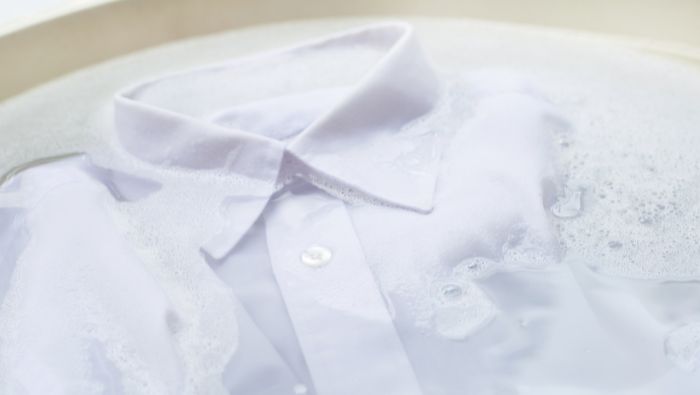Tips for Hand-Laundering ‘Dry Clean Only’ Clothing

The dry cleaning process is a chemical cleaning process, not a ‘dry’ method. Perhaps you don’t like the thought of having your clothes cleaned with these chemicals or maybe you just don’t like the cost. It’s no big secret that some clothing with a tag that says ‘Dry Clean Only’ (DCO) can be safely laundered at home. The Care Labeling Rule states only one method of cleaning must be communicated to the consumer, not all acceptable methods.
What will affect the success of home laundering are the following: fiber type, garment construction, fabric construction, dyes, printing processes, finishings, trimmings (example: beads), soil and stains. The following guidelines can help you better determine when a DCO item can be home-laundered and when you should take it to a professional cleaner. You’ll also discover tips for hand-laundering ‘dry clean only’ clothing.
Garmets Best Left to a Professional Dry Cleaner
It’s important when caring for your clothes to know when not to home launder. It is best to take a garment to a professional when:
- There are spots or stains on the garment (some home remedies can remove the dye).
- The garment is made from acetate fibers.
- It is a rayon garment. They often shrink in water. (I was left with a shorter skirt when I accidentally washed a rayon dress. Once water-washed, my rayon dress did not seem to shrink any further when water-washed.)
- There is a special finish on the garment. Such would include fabrics that are stiff. These may have a stabilizing finish to maintain the stiffness.
- The garment has a lot of structure, such as a suit. This would be extremely difficult to iron and not worth saving a few dollars. This also applies to a garment that requires a lot of attention when ironing (pleats).
- The garment is leather or suede.
- The garment is special to you.
- The garment says not to professionally iron.
- The garment is new and not of a fiber you have successfully home-laundered.
- Finally, if the feel, or hand, of the garment is important to you, as may be with a silk garment, dry clean it. I dry clean my new silks and home launder the older ones. Maintaining the original hand of silk is very important.
Garments Best To Launder at Home
Items I recommend not to take to the cleaner are garments with beads, sequins, delicate trims, and/or glued-on appliques. The glues have been known to dissolve, and the trims can dissolve in the chemical process or melt with the heat.
Sign Up for Savings
Subscribe to get money-saving content by email that can help you stretch your dollars further.
Twice each week, you'll receive articles and tips that can help you free up and keep more of your hard-earned money, even on the tightest of budgets.
We respect your privacy. Unsubscribe at any time.
How To Launder Dry Clean Only Items at Home
To select items to be home-laundered, I advise beginning with an older item and one that has a fiber content of which you are familiar. There are many polyester blouses that can be safely home-laundered.
Using a lot of cold water, add in a gentle cleanser and make sure to thoroughly dissolve the cleanser. Add the garment and gently wash. Some fibers, such as silk, are easily damaged when wet. This is why you should not twist or wring silk. I soak man-made fiber garments for 15 minutes or so, and then I rinse. I typically hang a polyester blouse on a (plastic) hanger, while silk garments are put on a towel, rolled to absorb excess water, unrolled and then laid flat on a dry towel.
It is important to note that some garments will fade when home-laundered. This normally occurs with natural fibers. This usually does not occur with man-made fibers. If the garment is special, take it to the professionals.
Many items marked “Dry Clean Only” need only be cleaned once a year. For example, this is the case with wool suits. Garments next to the body may need to be cleaned more frequently as they may absorb body oils. To care for these DCO garments, use a garment brush between wearings to remove surface soil. Also, air the garment one to two days before returning it to the closet.
Related: Tips for Avoiding Dry Cleaning Bills
Home Laundering Dry Clean Only Items Is a By-Hand Process
Home laundering is easy once you understand the do’s and don’ts. When washing at home, remember the following:
- Always use cold water, a hand process (machine washing may be too rough), and a gentle cleanser ( I have used Dove Dishwashing liquid).
- Never use bleaches, regular laundry cleansers, fabric softeners or rinse additives.
- Do not twist or wring the garment, as some items can be damaged by twisting or wringing them.
- Some protein fibers, like silk and wool, should be kept away from heat sources and sunlight.
- When drying the garment, dry it in such a way as not to stretch it. If necessary, or if in doubt, lay the garment flat on lots of towels.
- Do not try to dry in the dryer, as the heat and/or agitation can cause damage to the garment.
More Dry Cleaning Cost-Cutting Tips
- You clean and they press. You can also reduce the cost of dry cleaning by cleaning the garments at home but having the dry cleaner press them. I do this for silk blouses because I can’t get the wrinkles out as well as they can. I save about 40% on the cost of full service.
- Use coupons. Some cleaners meet the price on the competitors’ coupons, others will give you their coupon price. Obviously, you must ask.
- Know where the low-cost cleaner is located. This includes frequently visited places. I dry clean very little where I live. Most of it is done in the neighborhood where I grew up — 600 miles away. I visit three times a year and just save my items. If unsure which cleaners are cheapest, ask around.
- Use the per pound places. This works especially well if you have many lightweight garments. I used to go to one in an older neighborhood when I was in college.
I have used all of these suggestions, as I have a lot of items that must be dry cleaned. I recommend asking friends and family about a particular cleaner before using them. Then, take just one item as a “test.”
Reviewed March 2024
Popular Articles
On After50Finances.com
- 9 Things You Need to Do Before You Retire
- You Didn’t Save Enough for Retirement and You’re 55+
- When Empty Nesters Reorganize and Declutter Their Home
- Reinventing Your Career in Your 50s or 60s
- What Mature Homeowners Should Know about Reverse Mortgages
- 2 Reasons to Collect Social Security Benefits As Soon As Possible

